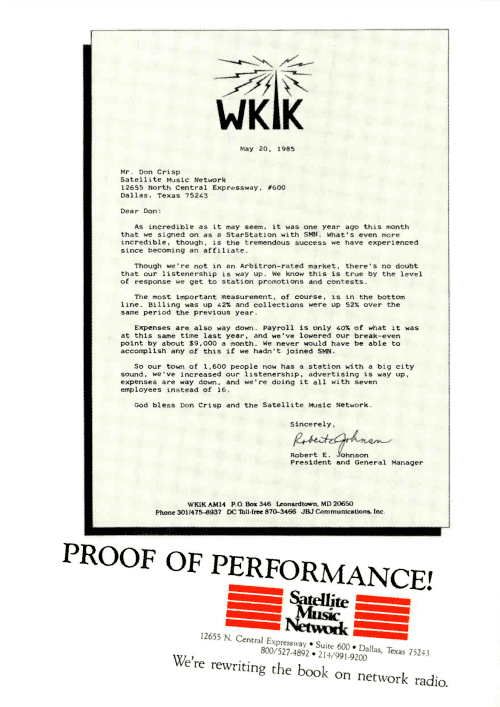Country United States Launch date 1981 | Dissolved 1989 Acquisition date 1989 | |
 | ||
Availability National, through regional affiliates Key people Bob Leonard, & Gary Semro | ||
Satellite music network vlj doing ac
Satellite Music Network was the first satellite delivered network to provide complete live 24-hour-a-day music programming to local stations, under several different formats.
Contents
- Satellite music network vlj doing ac
- Satellite music network vlj music of your life
- History
- Later added by ABC
- References
Satellite music network vlj music of your life
History
Affiliate stations, mostly in small and medium markets, could operate their stations virtually unmanned with nothing more than its existing tape-based playback equipment, a computer and a satellite hookup offering high quality air talent that they could never afford.
The concept was the presentation of live, carefully selected and rotated hit music, presented by experienced major market industry veterans over a satellite channel in real time.
Though nationally distributed, the presentation was localized by the network's talent pushing a button sending a subaudible tone over the network that would trigger a tape machine at the receiving station. For example, a button would be pressed triggering a local station's call letters and channel (referred to as "magicalls") at the receiving station that was pre-recorded by the talent. The talent would then wait anywhere from 3 to 5 seconds before beginning to speak. Another button pressed at the end of a talk break by the talent would trigger a cluster of local commercials at the receiving station, or a closure tone at the receiving station would send control back to the network if there were no commercials. The network provided music and DJ's, localized talent-matching liners, limited promotions support consisting of ideas used by other affiliates, and years later, a website. As the network moved from analog to digital satellite, it also provided receivers to affiliates to use on a loaned basis.
A "clock" was provided to affiliates outlining the placement of news and commercial cut-aways, and differed throughout the day and weekends. The clock included options for a 2-, 3-, or 5-minute newscasts at the top of the hour, followed by other holes for local spots. While the programming was live, DJ's had to avoid references to the weather or anything else that would not be appropriate in many time zones. An 800-line was eventually added, allowing the live DJ's to take phoned in requests.
SMN began in 1981 in Mokena, IL in a strip mall with two formats: AC (adult contemporary) - signed on by Bob Leonard (not the basketball player of the same name), and Country - signed on by Gary Semro. In less than three years, the network had signed more than 300 affiliates. By the late 1980s, SMN was broadcasting to more than 600 stations nationwide and in the Caribbean. In late 1989, SMN merged into ABC Radio (now Cumulus Media) and moved operations to Dallas, and expanded the number of available formats to ten. Today, this division is named Westwood One.
Bonneville Broadcasting also signed on with an easy listening format simultaneously to SMN - signed on by Tim Kolody from the same studios in August 1981. Bonneville pulled out of SMN in June 1984.
Among the talent that was employed at SMN was Chicago radio legend Eddie Hubbard on the Stardust format, Dean Richards who can be heard on WGN and WGN-TV in Chicago, Karen Williams of WNUA, Dennis Jon Bailey,now morning show host and Marconi Award winner at WIKY Radio in Evansville, News was done by Larry Langford also of WIND at the time and later WMAQ in Chicago and John Calhoun, who continues to broadcast in the Chicago market. A top 40 network called "The Heat" also existed, but little historical information is available for this network. The networks were later moved to Dallas, Texas, where talent on Country Coast to Coast included: Jim Casey, Steve Sharp, Jerry Walker, R.J. Steele, Mark Edwards, Becky Wight, Catfish Prewitt. On StarStation the talent included: Peter Stewart, Bob Leonard, John Lacy, and others. Country Coast to Coast in the early 1990s had the phone number 1-800-US-SONGS which later changed to 1-800-457-6647, Starstation 1-800-832-0208.
Later added by ABC
= Currently active on ABC Radio.
= Active on ABC Radio on a seasonal basis.
= Divested to other companies.
= Formats combined.
= Currently discontinued.
= Retained by origin of network.
